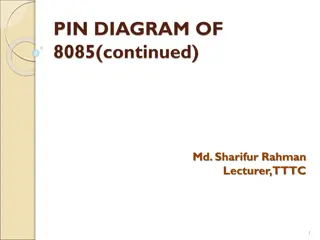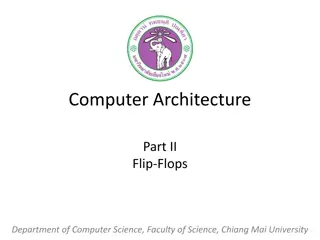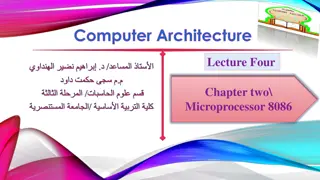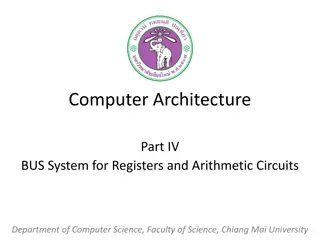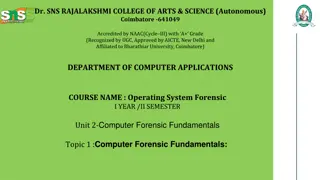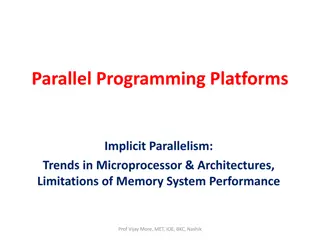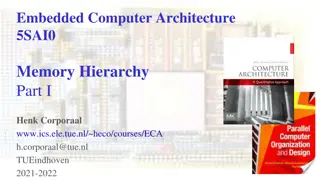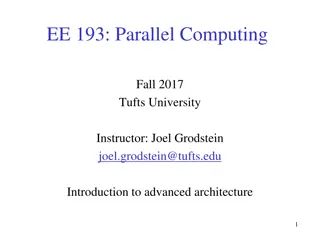Computer Architecture & Fundamentals of Microprocessor at Government College for Women
Department of Computer Science at Government College for Women in Kumbakonam offers a course on Computer Architecture & Fundamentals of Microprocessor. The course covers topics such as Von Neumann and Harvard Architectures, fixed-program computers, stored-program computers, and the differences between them in terms of design, functionality, and application in modern computing systems.
Download Presentation

Please find below an Image/Link to download the presentation.
The content on the website is provided AS IS for your information and personal use only. It may not be sold, licensed, or shared on other websites without obtaining consent from the author.If you encounter any issues during the download, it is possible that the publisher has removed the file from their server.
You are allowed to download the files provided on this website for personal or commercial use, subject to the condition that they are used lawfully. All files are the property of their respective owners.
The content on the website is provided AS IS for your information and personal use only. It may not be sold, licensed, or shared on other websites without obtaining consent from the author.
E N D
Presentation Transcript
GOVERNMENT COLLEGE FOR WOMEN(A) KUMBAKONAM DEPARTMENT OF COMPUTER SCIENCE COMPUTER ARCHITECTURE & FUNDAMENTALS OF MICROPROCESSOR STAFF NAME : S.SUNDARESWARI CLASS : III B.Sc (CS) Shift I & Shift II DATE : 4/08/2020 TIME : 10.30am to 11.30 am
COMPUTER ORGANIZATION | Historically there have been 2 types of Computers: Fixed Program Computers Their function is very specific and they couldn t be programmed, e.g. Calculators. Stored Program Computers These can be programmed to carry out many different tasks, applications are stored on them, hence the name. The modern computers are based on a stored-program concept introduced by John Von Neumann. In this stored-program concept, programs and data are stored in a separate storage unit called memories and are treated the same. This novel idea meant that a computer built with this architecture would be much easier to reprogram. It is also known as IAS computer and is having three basic units:
VON NEUMANN AND HARVARDARCHITECTURE Von Neumann Architecture: Von Neumann Architecture is a digital computer architecture whose design is based on the concept of stored program computers where program data and instruction data are stored in the same memory. This architecture was designed by the famous mathematician and physicist John Von Neumann in 1945.
Harvard Architecture: Harvard Architecture is the digital computer architecture whose design is based on the concept where there are separate storage and separate buses (signal path) for instruction and data. It was basically developed to overcome the bottleneck of Von Neumann Architecture.
VON NEWMANN ARCHITECTURE It is ancient computer architecture based on stored program computer concept. Same physical memory address is used for instructions and data. There is common bus for data and instruction transfer. Two clock cycles are required to execute single instruction. It is cheaper in cost. CPU can not access instructions and read/write at the same time. It is used in personal computers and small computers.
HARVARD ARCHITECTURE It is modern computer architecture based on Harvard Mark I relay based model. Separate physical memory address is used for instructions and data. Separate buses are used for transferring data and instruction. An instruction is executed in a single cycle. It is costly than von neumann architecture. CPU can access instructions and read/write at the same time. It is used in micro controllers and signal processing.
INTRODUCTION Computer architecture is the conceptual fundamental operational structure of a computer system. design and
Computer architecture can be classified into three main categories: Instruction Set Architecture, or ISA, is the image of a computing system that is seen by a machine language programmer. It includes the instruction set, word size, memory address modes, processor registers, and address and data formats. Computer Organization is a lower level and detailed description of the system that involves how the different parts of the system are interconnected and how they interoperate in order to implement the ISA. System Design which includes all of the other hardware components within a computing system such as: Computer buses and switches Memory controllers Direct Memory Access (DMA) Issues like multi-processing
EXAMPLE int a,b,c; scanf( %d %d,&a,&b); c = a + b printf ( %d ,c);
The Central Processing Unit (CPU) The Main Memory Unit The Input/Output Device Control Unit A control unit (CU) handles all processor control signals. It directs all input and output flow, fetches code for instructions and controlling how data moves around the system. Arithmetic arithmetic logic unit is that part of the CPU that handles all the calculations the CPU may need, e.g. Addition, Subtraction, performs Logical Operations, Operations, and Arithmetic Operation. and Logic Unit (ALU) The Comparisons. Bit It Shifting
Main Memory Unit (Registers) Accumulator: Stores the results of calculations made by ALU. Program Counter (PC): Keeps track of the memory location of the next instructions to be dealt with. The PC then passes this next address to Memory Address Register (MAR). Memory Address Register (MAR): It stores the memory locations of instructions that need to be fetched from memory or stored into memory. Memory Data Register (MDR): It stores instructions fetched from memory or any data that is to be transferred to, and stored in, memory. Current Instruction Register (CIR): It stores the most recently fetched instructions while it is waiting to be coded and executed. Instruction Buffer Register (IBR): The instruction that is not to be executed immediately is placed in the instruction buffer register IBR. .
Input/Output Devices Program or data is read into main memory from the input device or secondary storage under the control of CPU input instruction. Output devices are used to output the information from a computer. If some results are evaluated by computer and it is stored in the computer, then with the help of output devices, we can present it to the user.
Buses Data is transmitted from one part of a computer to another, connecting all major internal components to the CPU and memory, by the means of Buses. Types: Data Bus: It carries data among the memory unit, the I/O devices, and the processor. Address Bus: It carries the address of data (not the actual data) between memory and processor. Control Bus: It carries control commands from the CPU (and status signals from other devices) in order to control and coordinate all the activities within the computer.
BOOLEAN RULES AND THEIR DUALS Rule 1a : A+ 0 = A Rule 2a : A+1 = 1 Rule 3a : A+A =A Rule 4a : A+ = 1 1b : A.1 =A 2b : A.0 =0 3b : A.A = A 4b : A. = 0 Rule 5a : A 5a : A 6a : A (A+B) = A Rule 6a : A + AB =A Rule 7a : A+ = A+B 7a : A( + B) = A.B 8b : A(B+C) = AB +BC Rule 8a : A + BC = (A+B) (A+C) Rule 9a : AB + +BC = AB + 9b : (A+B)( +C)(B+C) = (A+B) ( +C)
ACTIVITY BINARY,DECIMAL,OCTAL and HEXA NUMBER SYSTEM,BCD,EXCESS 3 CODE,GRAY CODE. RAM ROM SRAM DRAM
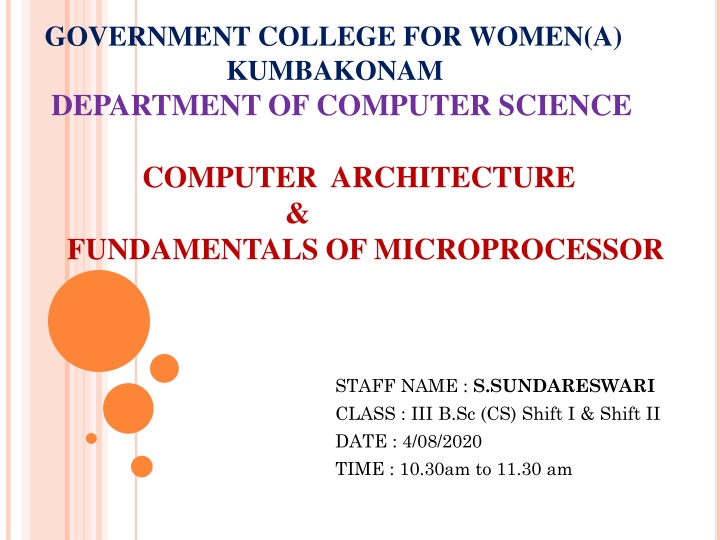

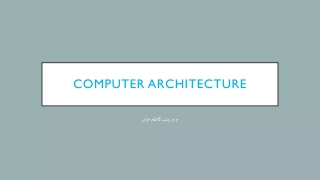
![❤Book⚡[PDF]✔ The Apollo Guidance Computer: Architecture and Operation (Springer](/thumb/21611/book-pdf-the-apollo-guidance-computer-architecture-and-operation-springer.jpg)



